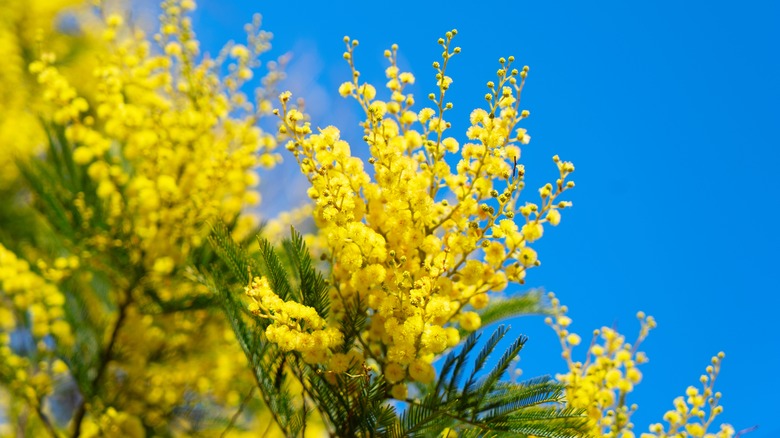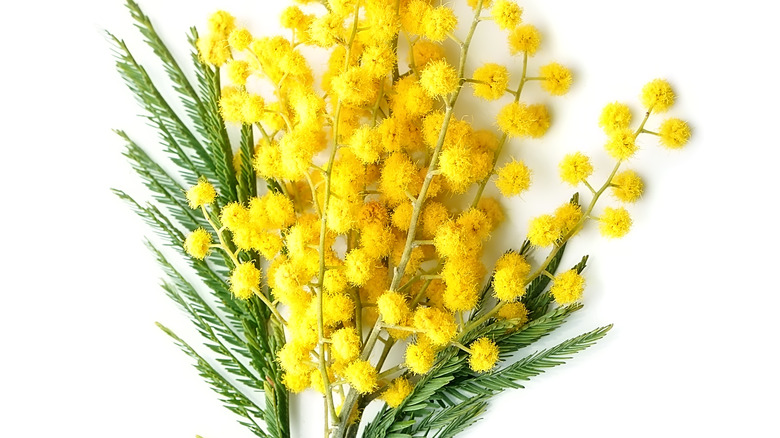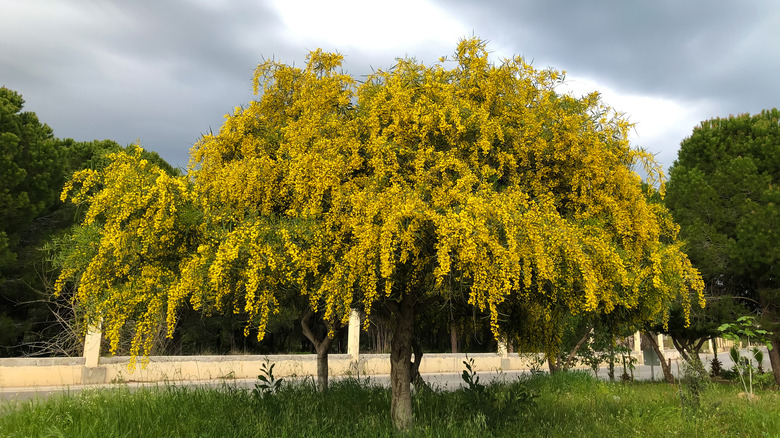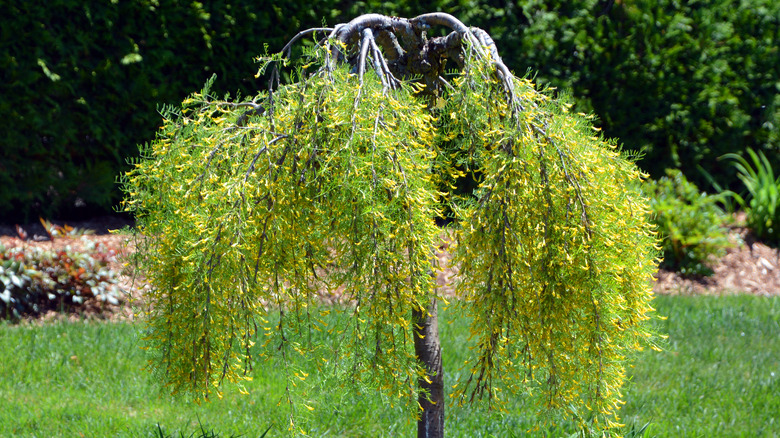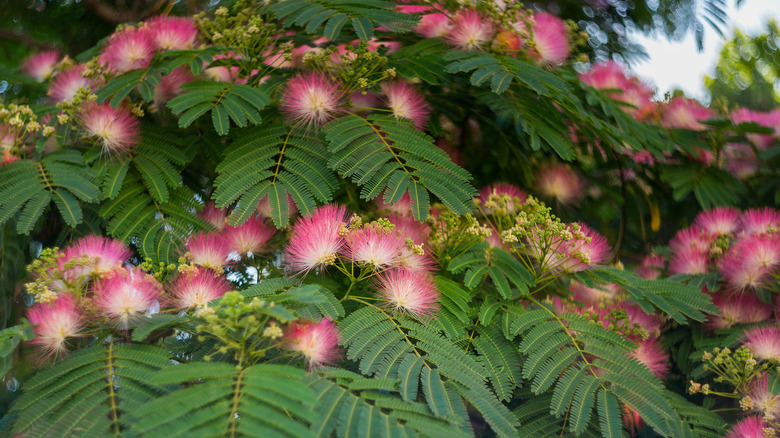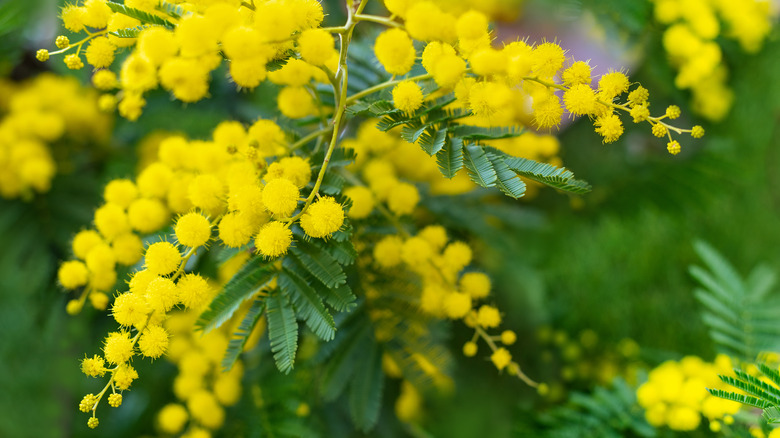How To Care For A Mimosa Flower
Mimosa flower, also known as silver wattle or blue wattle, is a genus that contains about 420 species. The genus includes a variety of flowering shrubs and trees; however, the taxonomy has changed throughout the years, and many plants that were once classified under mimosa are now in other genera. When referring to mimosa flowers, most people are actually thinking of the acacia dealbata, a winter flowering tree that belongs to the genus acacia.
These trees have bright yellow-orange blooms, the namesake of the famous orange-juice cocktail. Mimosa trees are native to Australia but are now grown worldwide, especially in the Mediterranean, where the climate allows them to flourish incredibly. Across the globe, but especially in Italy, the mimosa flower is a symbol for International Women's Day. In the 1940s, feminists in Italy chose the flower to represent women's strength, beauty, and sensitivity, according to Real Simple. If you live in a warm climate that receives sun year-round, mimosa trees can be a great addition to your property. They are relatively small evergreen trees, growing from 15 to 25 feet and blooming from winter into spring. Below we will discuss the uses of the acacia dealbata and talk you through the steps of caring for your tree.
How to use a mimosa in the garden
The acacia dealbata is widely used as an ornamental plant, and its expansive foliage makes it popular in gardens across the globe. Since it blooms from the winter into spring, planting a mimosa tree can brighten up a garden in the months when many other plants go dormant. In addition, the flowers are popular as cut flowers and used in arrangements by florists because of their color and fragrance.
In addition to ornamental use, the mimosa tree was used by the Ngunnawal people of Australia in more practical ways. According to Monash University, they used the bark to make ax handles, buckets, and string and mixed the gum of the tree for cement or to cover wounds. In addition, the high-quality timber is strong enough to be used for furniture, and you can use the tree's expansive root system to prevent soil erosion when planted on bare slopes.
How to grow a mimosa flower
The acacia dealbata, or the mimosa tree, grows best in well-drained, slightly sandy soil with some type of mulch or organic matter. Avoid soil with heavy clay components, as it will not allow the tree to drain properly. They are relatively fast-growing shrubs and can grow up to 20 inches per year. In the United States, they grow best in hardiness zones nine through 11; as such, they're most common in states with dry, warm climates like California and Texas.
There are a few options when deciding how to start growing your tree. CSBE recommends taking seeds from a dry seed pod and placing them in boiling water. Once they are cooled, put them in the soil. You can also plant a mimosa tree from hardwood cuttings, but you can also buy mimosa saplings in a nursery if you want to speed up the initial growth process. In this case, simply remove the sapling from the pot and place it into high-quality soil that will allow the tree to root. It is ideal for planting seeds, cuttings, or saplings in the summer. Keep in mind that you will need to thoroughly water the tree during its growth period at least once a week. After it reaches full maturity, your mimosa tree will not require any watering — it only needs the water it receives naturally from rain and can survive long periods of drought.
How to care for a mimosa flower
Caring for the mimosa is relatively easy. As stated before, you will not need to water your tree once it is fully mature. However, you should prune your tree annually to promote healthy growth and foliage — you can do so in the winter to spring blooming season. Shoot suckers will weaken your tree, so remove them as soon as they appear, Nature & Garden recommends. And because mimosa flowers are bright and highly fragrant, many people like to keep the flowers as decorative pieces for their homes when pruning.
A healthy mimosa tree will have access to full sunlight all year. However, if you are caring for a mimosa tree in a colder climate, it is best to keep it potted in a greenhouse during the winter months. The trees can survive moderate freezing for short periods, but any temperatures below 23 degrees Fahrenheit will ultimately kill or damage your plant. In the event of a cold spell, you can protect your tree with a horticulture fleece. They are generally safe from pests, but red spider mites, mealybugs, and scale insects are some bugs to look out for. If your plant does show signs of infestation, like yellowing or browning leaves, prune out any affected areas.
Mimosa flower varieties
As mentioned earlier, there are various different flowers known as mimosas, which can lead to confusion. Bipinnately composed leaves and wonderfully blossoming blooms in a rainbow of colors are common features of these trees. You should be cautious of importing mimosa trees because some varieties may be classified as invasive plants where you live, ProGardenTips warns. Generally speaking, mimosas are native to tropical and subtropical regions across the globe. Some of the most notable species from this genus include:
- Mimosa pudica (touch-me-not) — These plants are notoriously delicate, often called the sensitive plant, sleepy plant. When touched, the mimosa pudica will quickly close its leaves or droop, Real Simple notes. It blooms a pinkish-purple flower.
- Mimosa tenuiflora (Tepezcohuite) — This mimosa variety is native to Central and South America and is known for its medicinal qualities, per Healthline. It is also used to produce ayahuasca because of the DMT content in its root bark.
- Mimosa aculeaticarpa (The catclaw mimosa) — This variety is commonly found in the Sonoran desert across Arizona and into Mexico. It is a thicket-forming shrub that blooms with light pink flowers clustered together, World of Flowering Plants says.
- Mimosa borealis (Fragrant mimosa) — This plant grows as far north as southern Colorado and down to Texas and Mexico. It is known for its sweet-smelling blossoms, Lady Bird Johnson Wildflower center notes.
Are mimosa flowers toxic?
Generally, mimosa flowers from the acacia dealbata variety are not toxic to humans, though Shoot notes ingestion of any part of this mimosa tree may cause stomach discomfort. According to Horse DMV, the plant can be poisonous to horses, though they won't typically eat it as the flowers are usually unpalatable. The essence of mimosa flowers has been used in perfumes for years, and they are safe to touch and use around the house.
Though acacia dealbatas are usually safe, be cautious around other species. Some varieties, like acacia adunca, acacia acinacea, acacia acuminata ssp. acuminata, and acacia burkittii, contain the highly hallucinogenic compound DMT, according to MasterClass. Moreover, ensure you avoid acacia thorns in everyday situations, which can be found on a variety of trees and shrubs. But to prevent unintentional injury, it's important to place spiky acacias in a far corner of your garden.
How to repot a mimosa flower
Repotting your tree in the first years of its growth will be necessary if you live in a colder climate where the mimosa tree will need to be kept in a greenhouse for the winter or if you choose to grow your tree from a sapling that you bought at a nursery.
Nature & Garden suggests using a small pot to start, which will allow the roots to establish themselves. Once it is time to repot a sapling, gently loosen the soil and remove the plant from its container. Once it is out of the container, continue to slacken the soil surrounding the roots so that they have ample room to breathe. Keep the soil towards the top intact. Then, take your sapling and place it into a larger pot 3/4 full with a well-draining sandy or loamy soil. Lightly pack your sapling into the new soil and put additional dirt at the top to level out the contents. Suppose you live in a climate where your sapling will have proper soil and sun access, preferably a Mediterranean climate or USDA hardiness zone of nine through 11. In that case, it is a good idea to transfer your acacia dealbata into the garden.
